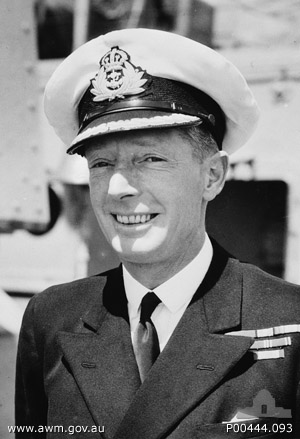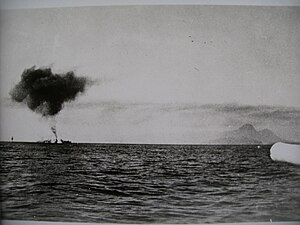
The Battle of Cape Matapan was a naval battle during the Second World War between the Allies, represented by the navies of the United Kingdom and Australia, and the Royal Italian navy, from 27 to 29 March 1941. Cape Matapan is on the south-western coast of the Peloponnesian Peninsula of Greece.

Vice Admiral Sir John Augustine Collins, was a Royal Australian Navy (RAN) officer who served in both World Wars, and who eventually rose to become a vice admiral and Chief of Naval Staff. Collins was one of the first graduates of the Royal Australian Naval College to attain flag rank. During the Second World War, he commanded the cruiser HMAS Sydney in the Mediterranean campaign. He led the Australian Naval Squadron in the Pacific theatre and was wounded in the first recorded kamikaze attack, in 1944.

HMS Hyperion was an H-class destroyer built for the Royal Navy during the mid-1930s. During the Spanish Civil War of 1936–1939, the ship enforced the arms blockade imposed by Britain and France on both sides as part of the Mediterranean Fleet. During the first few months of World War II, Hyperion searched for German commerce raiders in the Atlantic Ocean and blockaded German merchant ships in neutral harbours until she returned to the British Isles in early 1940. The ship participated in the Norwegian Campaign before she was transferred back to the Mediterranean Fleet shortly afterwards. Hyperion participated in the Battle of Calabria and the Battle of Cape Spada in July 1940 while escorting the larger ships of the fleet. The ship covered several convoys to Malta before she struck a mine and was deliberately scuttled in December 1940.

HMS Hasty was an H-class destroyer built for the Royal Navy during the mid-1930s. She was assigned to the Mediterranean Fleet until the beginning of World War II. The ship transferred to Freetown, Sierra Leone, in October 1939 to hunt for German commerce raiders in the South Atlantic with Force K. Hasty returned to the British Isles in early 1940 and covered the evacuation of Allied troops from Namsos in early May 1940 during the Norwegian Campaign. She was transferred back to the Mediterranean Fleet shortly afterwards and participated in the Battle of Calabria and the Battle of Cape Spada in July 1940. The ship took part in the Battle of Cape Matapan in March and evacuated British and Australian troops from both Greece and Crete in April and May. In June, Hasty participated in the Syria-Lebanon Campaign and was escorting convoys and the larger ships of the Mediterranean Fleet for the next year. During the Second Battle of Sirte in March 1942 she defended a convoy from an Italian battleship and several cruisers. While covering another convoy from Alexandria to Malta in June 1942 during Operation Vigorous, Hasty was torpedoed by a German motor torpedo boat and was so badly damaged that she had to be scuttled.

HMS Havock was an H-class destroyer built for the British Royal Navy in the mid-1930s. During the Spanish Civil War of 1936–1939, the ship enforced the arms blockade imposed by Britain and France on both sides as part of the Mediterranean Fleet. During the first few months of the Second World War, Havock searched for German commerce raiders in the Atlantic Ocean and participated in the First Battle of Narvik during the Norwegian Campaign of April–June 1940 before she was transferred back to the Mediterranean Fleet in May where she escorted a number of convoys to Malta. The ship took part in the Battle of Cape Spada in July 1940, the Battle of Cape Matapan in March 1941 and the evacuation of Greece in April 1941. She was damaged during the Battle of Crete the following month, but participated in the Syria–Lebanon Campaign in June.

The Leander class was a class of eight light cruisers built for the Royal Navy in the early 1930s that saw service in World War II. They were named after mythological figures, and all ships were commissioned between 1933 and 1936. The three ships of the second group were sold to the Royal Australian Navy (RAN) before World War II and renamed after Australian cities.

The Battle of Calabria known to the Italian Navy as the Battle of Punta Stilo, was a naval battle during the Battle of the Mediterranean in the Second World War. Ships of the Regia Marina were opposed by vessels of the Mediterranean Fleet. The battle took place 30 nmi to the east of Punta Stilo, Calabria.

HMAS Sydney, named for the Australian city of Sydney, was one of three modified Leander-class light cruisers operated by the Royal Australian Navy (RAN). Ordered for the Royal Navy as HMS Phaeton, the cruiser was purchased by the Australian government and renamed prior to her 1934 launch.

The Second Battle of Sirte was a naval engagement in the Mediterranean Sea, north of the Gulf of Sidra and south-east of Malta, during the Second World War. The escorting warships of a British convoy to Malta held off a much more powerful squadron of the Regia Marina. The British convoy was composed of four merchant ships, escorted by four light cruisers, one anti-aircraft cruiser and 17 destroyers. The Italian force comprised a battleship, two heavy cruisers, one light cruiser and ten destroyers. Despite the British success at warding off the Italian squadron, the Italian fleet attack delayed the convoy's planned arrival before dawn, which exposed it to intense air attacks that sank all four merchant ships and one of the escorting destroyers in the following days.

Giovanni delle Bande Nere was an Italian light cruiser of the Giussano class, which served in the Regia Marina during World War II. She was named after the eponymous 16th-century condottiero and member of the Medici family. Her keel was laid down in 1928 at Cantieri Navali di Castellammare di Stabia, Castellammare di Stabia; she was launched on 27 April 1930, and her construction was completed in 1931. Unlike her three sisters, the finish and workmanship on the vessel were not rated highly. She was sunk on 1 April 1942 by the British submarine HMS Urge.

The Condottieri class was a sequence of five light cruiser classes of the Regia Marina, although these classes show a clear line of evolution. They were built before World War II to gain predominance in the Mediterranean Sea. The ships were named after condottieri of Italian history.

The Battle of the Mediterranean was the name given to the naval campaign fought in the Mediterranean Sea during World War II, from 10 June 1940 to 2 May 1945.

Bartolomeo Colleoni was an Italian Giussano-class light cruiser, that served in the Regia Marina during World War II. She was named after Bartolomeo Colleoni, an Italian military leader of the 15th century.

The Alberto di Giussano class of light cruisers were a sub-class of the Condottieri class built before World War II for the Italian Regia Marina, to gain predominance in the Mediterranean Sea. They were designed by general Giuseppe Vian and were named after Condottieri of the Italian Mediaeval and Renaissance periods.

The First Battle of Sirte was fought between forces of the British Mediterranean Fleet and the Regia Marina during the Battle of the Mediterranean in the Second World War. The engagement took place on 17 December 1941, south-east of Malta, in the Gulf of Sirte. It was tactically inconclusive as both forces were limited by the strategic goal of protecting a convoy of their own and as such, neither were looking to force battle.

The Battle of Cape Passero (1940), was a naval engagement in the Second World War between the British light cruiser HMS Ajax and seven torpedo boats and destroyers of the Italian Regia Marina, south-east of Sicily, in the early hours of 12 October 1940. It took place in the aftermath of a British supply operation to Malta.

Operation MB8 was a British Royal Navy operation in the Mediterranean Sea from 4 to 11 November 1940. It was made up of six forces comprising two aircraft carriers, five battleships, 10 cruisers and 30 destroyers, including much of Force H from Gibraltar, protecting four supply convoys. It consisted of Operation Coat, Operation Crack, Convoy MW 3, Convoy ME 3, Convoy AN 6 and the main element Operation Judgement.

The Action in the Strait of Otranto [also the Battle of the Strait of Otranto (1940)] was the destruction of an Italian convoy on 12 November 1940 during the Battle of the Mediterranean in the Second World War. It took place in the Strait of Otranto in the Adriatic Sea, between the Royal Navy and the Italian Royal Navy.
Force B was the name of several British Royal Navy task forces during the Second World War.

Ferdinando Casardi was an Italian admiral during World War II.


















